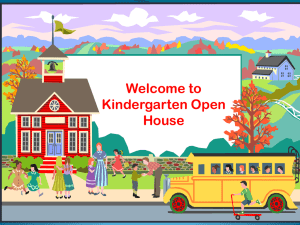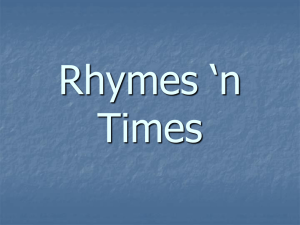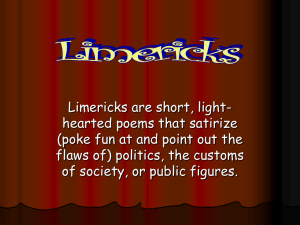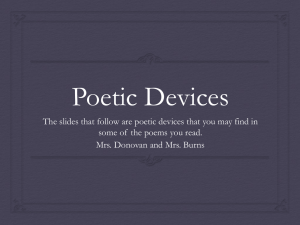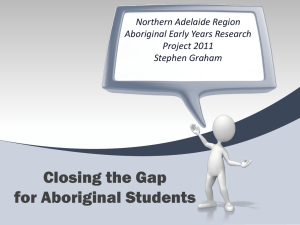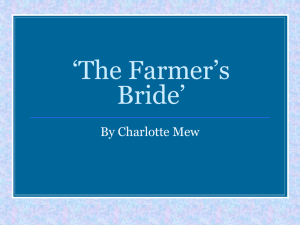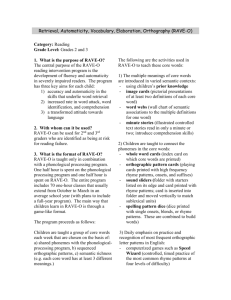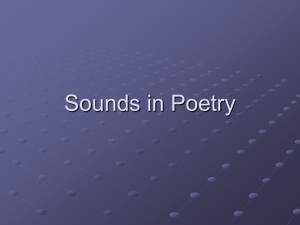Literacy Night PowerPoint
advertisement
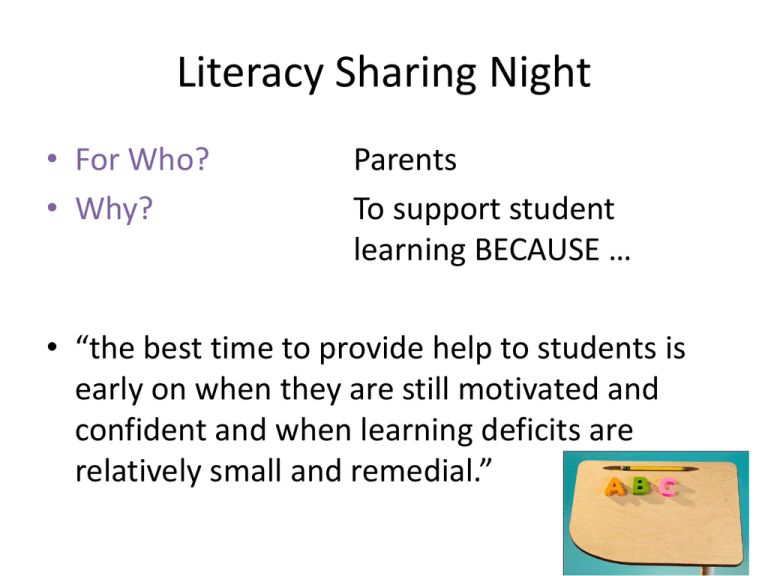
Literacy Sharing Night • For Who? • Why? Parents To support student learning BECAUSE … • “the best time to provide help to students is early on when they are still motivated and confident and when learning deficits are relatively small and remedial.” Components of Literacy • Oral Language • Phonological Awareness/Phonemic Awareness – Concepts of print • Vocabulary/Word Work • Fluency • Comprehension Did you Know? • “Prereaders’ letter knowledge is the single best predictor of first-year reading achievement, with their ability to discriminate phonemes auditorily ranking a close second.” • “Approximately 20 percent of students have some difficulty with phonological awareness, with about 7-10 % having substantial difficulty.” • Council for Exceptional Children Phonological Awareness • Refers to an understanding of the sound structure of language-that is, that language is made up of words, syllables, rhymes and sounds (phonemes). Word Awareness/Syllable Awareness • Clap the number of words in a sentence • Practice hearing the beats or syllables in words (hand under chin method) • Elkonin Boxes Rhyme Awareness • Segment: • Delete m-an -an (to know you can take a sound away) – Eg. Say cowboy. Say it again, but do not say boy • Substitute c-an (to know how to add a sound at the beginning) – Say “car”. What word would we make if we change the “c” to and “f”? • Blend m-an = man -A hunting we will go Rhyme Awareness • Descriminating Rhyme – Odd Word Out Game Provide 3 words, two of which rhyme. Ask child which word does not rhyme and how they know. – Toss the ball As the ball is tossed, one student says a word (e.g. cat) and the student who catches the ball provides a rhyming word. Reading Comprehension – Before reading • Look through the book. – What is the title? – Who are the author and the illustrator? – Describe the front and back cover of the book (words, pictures, what it makes you think of) – Does your book have chapters, sections titles, headings, diagrams, an index, a glossary, pictures, and table of content? – Look at the pictures. • Is your book fiction or nonfiction? How do you know? • Think about the following questions: What do I already know about this subject? What do I want to learn? What have I learned? (Last question is after you read.) • What are several things you think you will learn from reading this text? • Make predictions - Just by looking at the book, what do you think will happen? What is this book about? • Look for certain sounds in the book. Reading Comprehension – While reading • Write down several ideas you had while reading (thoughts, questions, ideas that pop into your head.) • Write down any new words or words you found interesting. • Make predictions - What do you think will happen next? • Ask who did what and why? • Create questions about your book. Try using who, what, which, where, when, why, does, who, if in your questions. Don’t forget to find the answer. • Connect the book you read (or are reading) to something that has happened in your life, to something you remember about another book or something you know about the world. Don’t forget to say what it is connected to in your book. Reading Comprehension – After reading • • • • • • • • Create questions about your book. Try using who, what, which, where, when, why, does, who, if in your questions. Don’t forget to find the answer. Connect the book you read (or are reading) to something that has happened in your life, to something you remember about another book or something you know about the world. Don’t forget to say what it is connected to in your book. If you read a fiction book, write about what has happened so far in the book, the setting, a character or something funny that happened. If you read a non-fiction book, write or talk about the main idea of the book, share the new information you learned or ask the author a question. What do you think is the most important thing the author wants you to learn from this book? Why? Write a summary that included the important ideas and facts of the text. Use a graphic organiser to show main ideas. Discuss what you liked and didn’t like about the book.
